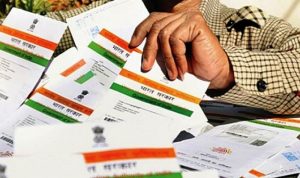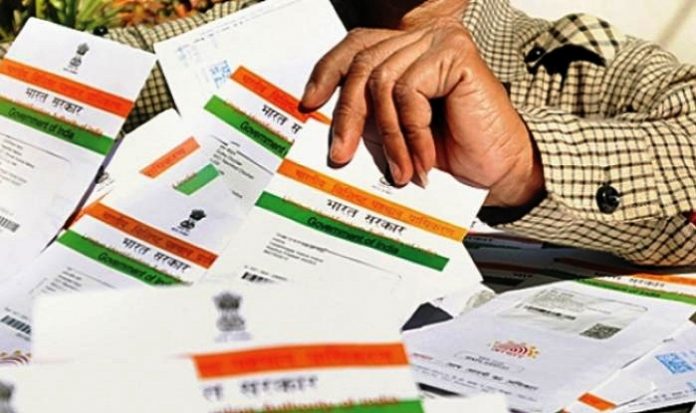This post has been written by Aditya Shrivastava from team iPleaders

Aadhar has been facing a sufficient amount of criticism ever since it was proposed. The hearing of the validity of Aadhar is currently progressing in the Supreme Court of India with a five judge bench taking over the issue. The court has dispersed for lunch and will reassemble at 2:30 PM for further hearing. The Senior Advocate Shyam Divan submitted the opening statements and had a plethora of concerns to raise. He started off by saying “We will out before you what Aadhar Project is all about.”
A brief history of Aadhar can be summed into following list of dates and events.
| Date | Event |
| 2009 | Vide notification UIDAI was established |
| 2010 | Adhar program was launched in Maharashtra |
| Dec 2010 | Bill introduced in the Parliament. Very similar to what finally became the Aadhar Act. |
| Post-2010 | Bill was referred to the standing committee on Finance, which pointed out lacunae pertaining to privacy, security, private players. |
| 2012 | PIL filed against Aadhar scheme |
| 2013 | 2 judge bench referred the matter for final hearing and made it clear that no one should suffer from the lack of an Aadhar card. |
| 2014 | UIDAI filed a petition against the Bombay high court order that had directed it to disclose biometrics in a criminal case. Interim order making Aadhar voluntary was sustained through multiple hearings. |
| October 2015 | Use of scheme partially extended |
| Till 2016 | Citizens were functioning only under an administrative direction. No checks and balances |
| 2016 | Aadhar act passed. |
| January 2017 | Notification issued making Aadhar mandatory for multiple services. Aadhar has been made mandatory for opening bank accounts, holding insurance policies, making transactions, mutual funds. |
| January 2018 | Final hearing for the Aadhar case listed before the five-judge bench. |
In the words of Shyam Divan, “Aadhar inverts the relationship between the citizens and the state.” After taking the court through a list of dates and events, Shyam Divan introduced the petitioners who come from extremely diverse backgrounds. He introduced them as individuals from rural India who work on field for whom Aadhar is proving to be a system of exclusion, petitioners who work for children and schools, former military personnels who have concerns about safety and national security, manual scavengers. His point was essentially to discard the state’s claim that this is an elitist concern and establish that these are issues which might make a democratic system hollow.
He then goes ahead to explain how the whole system is probabilistic and how that is flawed because right to entitlement cannot be based on mere probability. And points out how the various agencies which have been working in association with UIDAI have been working for seven years without checks and balances with such high security data.
Post the lunch break, Shyam Divan took the bench through the composition and functions of UIDAI. He emphasized that through the progress of the case, he will be able to establish that there was negligible government control or oversight over such highly confidential data. His contention was “ when you are picking up sensitive data there must be some standard of governance.” Shyam Divan also pointed out that prior to the Aadhaar Act, there was no mention of biometrics in the legal instruments that govern Aadhar.
It was during this contention, when Justice A.K. Sikri raised a concern as to whether it is the result of illegality of biometrics that the database needs to be destroyed? To which Shyam Divan agreed and said, “biometric collection is patently illegal and that illegality doesn’t get cured by passing Aadhar Act alone.”
Going further, Shyam Divan explains how authentication works by giving an example of how it works at an airport. Stating that a biometric reader any or may not have GPS. It is possible to know due to the gps that at such time, Mr. X entered the airport. Even when one does not have gps, the fingerprint is transmitted by the CIDR and can be traced back.
Two things can be determined through this :
1) There was an authentication at such time.
2) The location (because of the GPS.)
When you scale this up, you get a complete profile of the individual’s actions.
Earlier in the morning, Mr. Divan stated that UIDAI captures all ten fingerprints of the individual, a facial photograph and the two irises. This particular data is stored. They have a template. The template scales the fingerprint. Then pick up lets say, a 100 distinctive points called minutae. The UIDAI then sets a number – how many of those 100 points should match? If the number is set 100 by 100 it will never work. Thus, UIDAI needs to make a value judgement. So, you are departing from a deterministic system to a probabilistic system.
Shyam Divan exclaimed that the difference is between a pervasive and a non pervasive system.The system is one that throughout the day there will be an electronic trail. The question is not whether they are actually tracking or not, but whether such an architecture is possible.
It was at this point when Justice Chandrachud questioned the petitioner “would it be taken care of if the data was used for the purpose for which it was collected?” Mr Divan replied stating that the core issue is that the design in itself is bad and enables state domination. In the words of Shyam Divan: ” while that one point UIDAI projected the purpose of Aadhar was to give everyone give an identity, RTI revealed that for the total number of people for whom Aadhar was the first identity very small.”
Justice D.Y. Chandrachud went ahead to further ask the petitioner : “why the can’t the State say that biometrics are needed to prevent social welfare leakage and go to the right persons.” To which Shyam Divan said that, “the question shall remain even if Aadhaar plugs leakages. Is it a proportionate method of doing so?”
Shyam Divan took the bench through the standing committee on finances report on the old Aadhaar bill. He pointed towards the concerns expressed by the standing committee on issues of privacy, security and data theft; concerns with respect to manual laborers, concerns about civil liberties, surveillance and profiling – in the absence of a data privacy law in India. Mr. Divan also discussed the concerns expressed by the NHRC about the privacy.
While taking the bench through the observations and recommendations of the standing committee, which pointed out that pending any law, any bi-executive action would be unethical and in violation of parliamentary prerogatives, Shyam Divan made sharp references to the finding of the standing committee that executive operation of Aadhaar scheme even as NIDAI bill which was pending before the parliament was unethical and unconstitutional.He went ahead and pointed out the concerns of the financial committee about illegal immigrants. It was throughout this argument that he time and again remarked that the scheme appears to be not thought well through.
CJI Dipak Misra the probed : “How is the standing committee report of 2010 is relevant to 2016 act?” Mr. Divan then explained that the reference is inevitable because the problems pointed out then continue to exist even in the current model, and it is relevant to establish the same. Justice Misra then raised the issue of the Money Bill. Mr. P. Chidambaram Senior Advocate along with Mr. Arvind Dattar, Senior Advocate took over and explained the position with respect to the arguments in regards with the money bill.
Shyam Divan continued quoting the standing committee report categorically stating that “the old bill in its present form is unacceptable.”
In the few final minutes Mr. Shyam Divan took the court through a few notifications that came in after the standing committee ; and the passage of the Aadhaar act. With this Mr. Divan complete the pre-act chronology.
The bench rose up at 4:00 PM. The bench shall resume hearing the case tomorrow at 11:30 AM.
The link to the report of the Standing committee on finance, to which Mr. Divan has made time and again reference to can be found here!
We will be back with the live updates tomorrow. Follow our facebook page or twitter account for live updates. Do not miss our blog for more such interesting updates about law.











